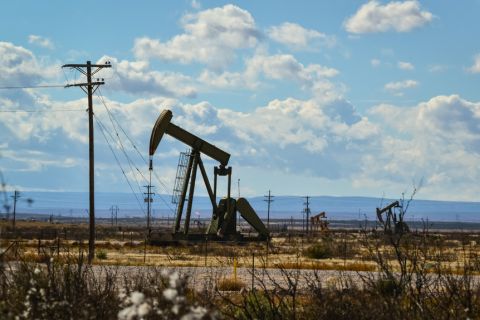
(Source: Shutterstock.com)
When it comes to reducing global methane emissions, some oil and gas industry players have put existing and emerging technologies to use.
However, there is still work to be done in areas such as applying best practices, improving data accuracy, establishing industrywide standards and incorporating regulatory incentives, according to panelists speaking during a recent Society of Petroleum Engineers webinar.
The discussion comes amid increased pressure from investors to curb emissions to limit global warming.
The good news is “it’s an easy win. The technology exists,” said Darcy Spady, managing partner of Carbon Connect International. He noted that methane is 25 times worse than CO2 from a global warming perspective. “We have a chance to really come out of the gate strong and have some solid, easy wins and do a lot of good for the planet.”
Several companies have put lowering emission of methane, the key ingredient of natural gas and a primary component of ground-level ozone, at the forefront.
BP Plc, for example, aims to reduce the methane intensity of its operations by 50%. Its toolkit includes gas cloud imaging, video imaging spectral radiometry, drones that livestream data, handheld gas leak detectors and smart glasses for field operators to gather sensor information, according to its website.
BP along with Total SA, Royal Dutch Shell Plc and others have teamed up, working to transition to a low-carbon future in support of the Paris Agreement, as part of the Oil and Gas Climate Initiative (OGCI). Other companies are tackling similar initiatives solo or as parts of other collaborations.
Efforts vary greatly among companies, panelists said.
“Some are doing very well. There are others who are simply not paying as much attention to this issue,” said Tim Gould, head of division for energy supply outlooks and investment at the International Energy Agency. “The issue is not just about raising standards among the best but to get attention from across the whole spectrum of industry actors. And that, I think, is a crucial challenge.”
Regulation is also critical in moving the methane reduction needle further, according to Julien Perez, vice president of strategy and policy for OGCI.
“To do that means that you have to get some standards across the industry on how you can address methane,” he said. “How are you going to detect and mitigate the methane emissions? There is a number of initiatives that are going on within this space,” including with OGCI which also engages with countries needing to establish frameworks.
Reporting verification by third parties is also needed along with scaling up the use of traditional technology like infrared cameras and emerging technologies like aircraft and satellites for emission detection.
In the near-term, the industry can make a step-change in lowering emissions by not only improving data quality but also by establishing methane emissions targets and following best practices such as those outlined in the Methane Guiding Principles Best Practices Toolkit, said Wendy Brown, environmental director for the International Association of Oil and Gas Producers. Among these practices are the use of flaring pneumatic devices and leak detection and repair.
Regarding data, she said the industry can build trust with not just bottom-up estimations and measurements, but also top-down reconciliation by others.
She said the credibility of gas as a solution for the energy transition depends on the industry’s ability to tackle methane emissions, though the industry is responsible for only about 12% of overall methane emissions.
“In our view, there’s still a lot of work to do to really ingrain that culture of methane abatement into company operations in the same way that you’ve seen for safety over many decades,” she said. But lower emissions from some leading companies show it’s possible. “They typically found that it's easier and cheaper than they had anticipated upfront.”
Gould said about 75% of the estimated 80 million tons of annual methane emissions from oil and gas operations is technically possible to abate.
“More than 40% of that total, we think could be at no net cost,” he said. “The value of the captured methane will be higher than the abatement measure.”
So why haven’t such measures been widely adopted worldwide?
It could be lack of awareness about emissions levels or cost effectiveness of abatement, insufficient infrastructure or an inability to see the value amid competition for capital, Gould said. “Tackling some of those barriers is also going to be important. There are ways of doing that. It’s really a question of building up that momentum.”
The industry has had many bad practices, Spady said.
“How many times in the drilling and completion world did we see in the procedure ‘vent to atmosphere?’ Who’s the guy on the valve bar blowing back the whatever to the skies,” Spady said. “These are practices that us old geezers did for years and years in the field. We can’t do them anymore.”
If internal managers don’t see the investment case, someone else may.
“The bankers are going to make it really easy because the people who fund the banks are saying … we need to think about the environment. So, Mr. Banker, Ms. Banker, you’re not giving a loan to this oil company unless they can account for carbon,” Spady said. “I think the world is changing very rapidly.”
Recommended Reading
Range Resources Holds Production Steady in 1Q 2024
2024-04-24 - NGLs are providing a boost for Range Resources as the company waits for natural gas demand to rebound.
EQT Sees Clear Path to $5B in Potential Divestments
2024-04-24 - EQT Corp. executives said that an April deal with Equinor has been a catalyst for talks with potential buyers.
Novo II Reloads, Aims for Delaware Deals After $1.5B Exit Last Year
2024-04-24 - After Novo I sold its Delaware Basin position for $1.5 billion last year, Novo Oil & Gas II is reloading with EnCap backing and aiming for more Delaware deals.
Matador Hoards Dry Powder for Potential M&A, Adds Delaware Acreage
2024-04-24 - Delaware-focused E&P Matador Resources is growing oil production, expanding midstream capacity, keeping debt low and hunting for M&A opportunities.
TotalEnergies, Vanguard Renewables Form RNG JV in US
2024-04-24 - Total Energies and Vanguard Renewable’s equally owned joint venture initially aims to advance 10 RNG projects into construction during the next 12 months.






